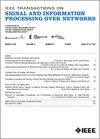Multivariate Time Series Forecasting With GARCH Models on Graphs
IF 3
3区 计算机科学
Q2 ENGINEERING, ELECTRICAL & ELECTRONIC
IEEE Transactions on Signal and Information Processing over Networks
Pub Date : 2023-08-10
DOI:10.1109/TSIPN.2023.3304142
引用次数: 0
Abstract
Data that house topological information is manifested as relationships between multiple variables via a graph formulation. Various methods have been developed for analyzing time series on the nodes of graphs but research works on graph signals with volatility are limited. In this article, we propose a graph framework of multivariate Generalized Autoregressive Conditional Heteroscedasticity (GARCH) models from the spectral perspective with the Laplacian matrix. We introduce three graphical GARCH models: one symmetric Graph GARCH model and two asymmetric models namely Graph Exponential GARCH and Graph GJR-GARCH. Assuming that graph signals and their residuals are基于图上GARCH模型的多变量时间序列预测
包含拓扑信息的数据通过图形公式表现为多个变量之间的关系。已经开发了各种方法来分析图节点上的时间序列,但对具有波动性的图信号的研究工作有限。在本文中,我们从谱的角度提出了一个具有拉普拉斯矩阵的多元广义自回归条件异方差(GARCH)模型的图框架。我们介绍了三种图形GARCH模型:一种是对称图形GARCH,另一种是非对称图形指数GARCH和图形GJR-GARCH。假设图信号及其残差是图平稳的,该框架可以将多变量GARCH模型分解为图谱域中几个单变量GARCH过程的线性组合。此外,通过利用频域中的图信号的主分量,可以减少具有图拓扑信息的参数的数量,并进一步降低估计成本。这些提出的模型在合成数据和天气预测和风电预测的两个实际应用上进行了测试。在数据和GARCH模型残差为图平稳的情况下,实验结果表明,这三个图模型比非图GARCH模型和图向量自回归移动平均模型能够更准确地进行多步预测。
本文章由计算机程序翻译,如有差异,请以英文原文为准。
求助全文
约1分钟内获得全文
求助全文
来源期刊

IEEE Transactions on Signal and Information Processing over Networks
Computer Science-Computer Networks and Communications
CiteScore
5.80
自引率
12.50%
发文量
56
期刊介绍:
The IEEE Transactions on Signal and Information Processing over Networks publishes high-quality papers that extend the classical notions of processing of signals defined over vector spaces (e.g. time and space) to processing of signals and information (data) defined over networks, potentially dynamically varying. In signal processing over networks, the topology of the network may define structural relationships in the data, or may constrain processing of the data. Topics include distributed algorithms for filtering, detection, estimation, adaptation and learning, model selection, data fusion, and diffusion or evolution of information over such networks, and applications of distributed signal processing.
 求助内容:
求助内容: 应助结果提醒方式:
应助结果提醒方式:


